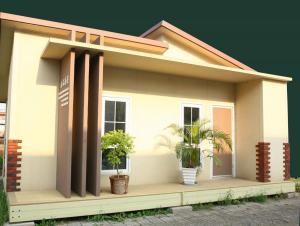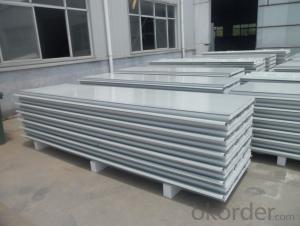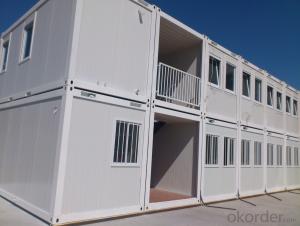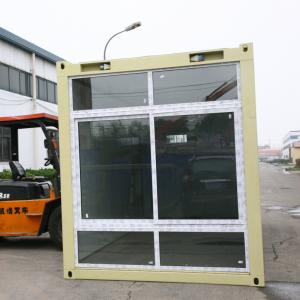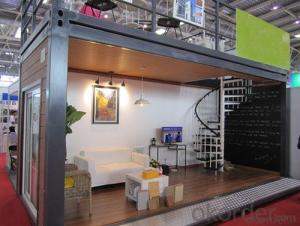Container House with Two Floors Made in China of CNBM
- Loading Port:
- Tianjin
- Payment Terms:
- TT OR LC
- Min Order Qty:
- 6 set
- Supply Capability:
- 50000 set/month
OKorder Service Pledge
OKorder Financial Service
You Might Also Like
Container House with Two Floors Made in China of CNBM
Product Description:
1. The house is made of light steel structure and rustproof color steel sandwich panel as wall and roof.
2. The size and layout can be designed as per customers' requirements for its flexible dimension
3. The house has waterproof structure and heating insulation material, such as EPS, Rock wool or PU Panels interlock easily to form a complete thermally efficient shell.
4. Two kinds of flooring system are available, one is steel chassis floor, the other is concrete foundation.
5. One 40’HQ container can load about 160m2 considering 75mm thickness panel for roof and wall;
Our service:
1. House Production accordingto customer layout , design , specification and material list demand.
2. We have standard house model, but we can also make design according to customer specialized target orbudget per m2. This way we can get a agreement in the shortest time.
3. We can supply thefurniture, electricity and sanitary fittings, but we can only supply Chinese standard and design style. If small quantity, the best way is to purchase thefittings by customer in their site.
FAQ:
1.How about the installation? For example, the time and cost?
To install 200sqm house needs only 45 days by 6 professional workers. The salary of enginner is USD150/day, and for workers, it's 100/day.
2.How long is the life span of the house?
Around 50 years
3. And what about the loading quantity?
One 40'container can load 140sqm of house.
Images:
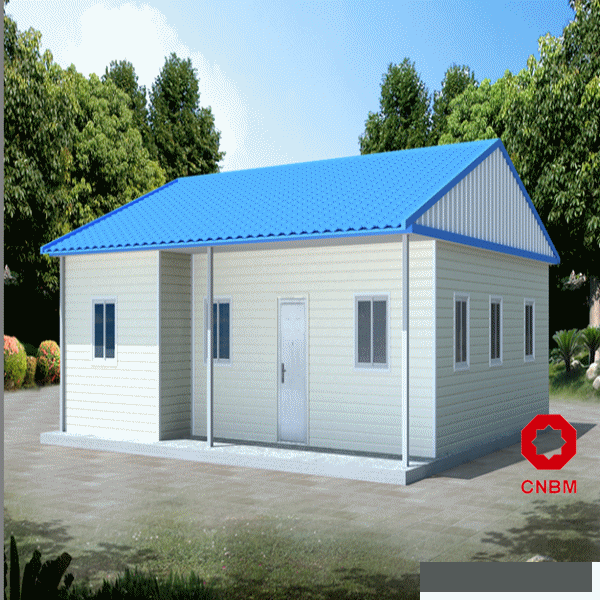
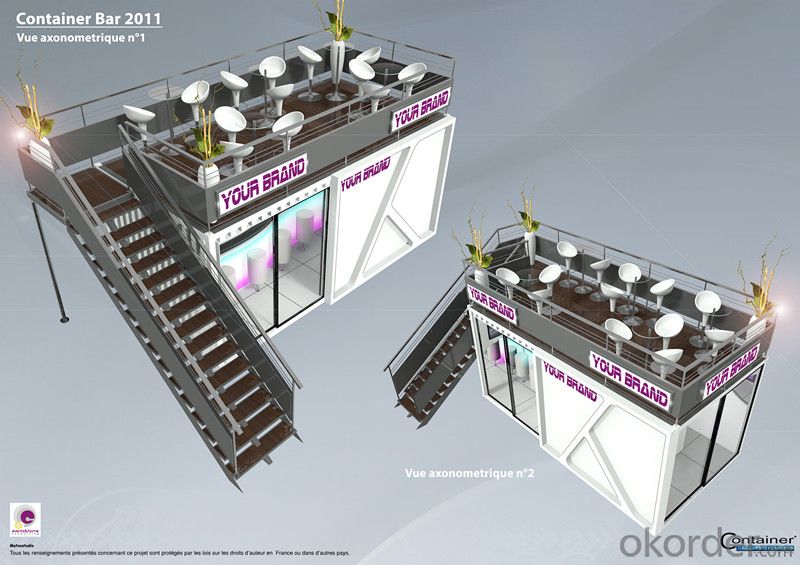
- Q:Are container houses resistant to floods or water damage?
- Floods or water damage can be resisted by container houses if they are designed accordingly. Waterproofing and flood resistance can be achieved through the use of appropriate construction techniques and materials. The primary concern is to ensure the proper sealing of the containers and the implementation of effective water drainage systems. Furthermore, elevating the containers on a raised foundation or incorporating flood-resistant designs can provide an additional level of protection against flooding. It should be emphasized that the specific location and severity of the flood must also be taken into account when considering the flood resistance of container houses.
- Q:Are container houses fire-resistant?
- Container houses can be made fire-resistant, but it depends on the materials used during construction. The steel structure of shipping containers itself is fire-resistant to some extent, as steel is a non-combustible material. However, the interior and exterior finishes of the container house, such as insulation, cladding, and roofing, will determine the overall fire resistance. To enhance fire resistance, container houses can be constructed using fire-resistant materials like mineral wool insulation, which has a high resistance to fire. Additionally, fire-resistant cladding materials such as cement fiberboard or metal panels can be used to further protect the container house from fire risks. Fire-resistant roofing materials like metal or concrete can also be utilized to minimize the risk of fire spreading through the roof. It is important to note that while container houses can be made fire-resistant, it is crucial to follow building codes and regulations to ensure proper fire safety measures are implemented during construction. This may include the installation of fire alarms, smoke detectors, fire extinguishers, and adequate escape routes. Overall, with the use of appropriate materials and adherence to fire safety standards, container houses can be made fire-resistant, providing a safer living environment for its inhabitants.
- Q:Are container houses suitable for Airbnb investment properties?
- Container houses can be a great option for Airbnb investment properties for several reasons. First, container houses are known for their unique and modern design, which can attract a wide range of guests looking for a memorable and Instagram-worthy experience. These houses often have a sleek and minimalist aesthetic, making them appealing to younger travelers who prefer trendy and unconventional accommodations. Additionally, container houses are typically more cost-effective to build compared to traditional houses, which can be advantageous for investors seeking higher returns on their investment. Moreover, the construction process for container houses is usually faster, allowing investors to start generating income from their Airbnb property sooner. Furthermore, container houses are highly customizable and can be designed to accommodate various amenities and features that guests look for in an Airbnb listing. From fully-equipped kitchens to comfortable living spaces and even outdoor areas, container houses can be transformed into cozy and functional spaces that provide a comfortable stay for guests. In terms of sustainability, container houses are often built using repurposed shipping containers, which helps reduce waste and promote eco-friendly practices. This can be an attractive aspect for environmentally conscious guests who prioritize sustainable travel options. However, it is important to consider the location and target market when investing in container houses for Airbnb. Some areas may have stricter regulations or restrictions regarding container houses, so thorough research and understanding of local regulations are necessary. In conclusion, container houses can be a suitable investment for Airbnb properties due to their unique design, cost-effectiveness, customizability, and potential appeal to a wide range of guests. However, careful consideration of location and local regulations is crucial to ensure a successful investment.
- Q:Can container houses be designed with a rooftop deck?
- Yes, container houses can definitely be designed with a rooftop deck. In fact, the modular nature of container homes makes them perfect for incorporating rooftop decks. By stacking and connecting multiple containers, it is possible to create a multi-level structure with a rooftop deck on top. The deck can be designed to provide additional outdoor living space, offering panoramic views and a place to relax and entertain. Additionally, container homes can be customized and modified to include various features like staircases, access points, and safety measures, ensuring a functional and enjoyable rooftop deck experience.
- Q:Are container houses suitable for educational facilities?
- Educational facilities can indeed find suitability in container houses. The recent years have witnessed a surge in popularity for container houses, also known as shipping container structures, owing to their cost-effectiveness, resilience, and eco-friendliness. These qualities make them an appealing choice for educational facilities, particularly in areas where traditional construction methods may be expensive or limited. The adaptability of container houses permits easy modification and customization to cater to the specific needs of educational institutions. They can be transformed into classrooms, libraries, laboratories, or even administrative offices. The modular nature of these structures allows for seamless expansion or reconfiguration, ensuring accommodation for a growing student population or changing educational demands. Furthermore, container houses offer portability and the option to relocate if required. This flexibility proves particularly advantageous for educational facilities that necessitate temporary structures or must adapt to evolving circumstances, such as disaster-stricken regions or areas experiencing fluctuations in student populations. Moreover, container houses demonstrate environmental friendliness. Repurposing shipping containers aids in waste reduction and supports sustainable building practices. These structures can also incorporate energy-efficient features like solar panels and rainwater harvesting systems, further lessening their environmental impact. Nevertheless, it is crucial to consider certain factors prior to implementing container houses as educational facilities. Adequate insulation, ventilation, and climate control must be ensured to create a comfortable and conducive learning environment. Accessibility and adherence to safety regulations should also be taken into account to meet the requirements of students with disabilities. In conclusion, container houses can indeed present a feasible alternative for educational facilities due to their affordability, adaptability, and sustainability. However, meticulous planning, design, and consideration of specific educational needs are imperative to guarantee a successful implementation.
- Q:Are container houses suitable for remote working or telecommuting?
- Yes, container houses can be suitable for remote working or telecommuting. These houses are designed to provide comfortable living spaces with all the necessary amenities, including dedicated work areas. They can be customized to include home offices or studios, ensuring a conducive environment for productivity and focus. Additionally, container houses are often located in serene and remote areas, offering peace and tranquility, which can further enhance remote working experiences.
- Q:Are container houses safe to live in?
- When container houses are designed, constructed, and maintained properly, they are indeed safe to live in. These houses are made from steel shipping containers, which are highly durable and designed to withstand even the harshest transportation conditions. They have been extensively tested and proven to be structurally sound, capable of withstanding hurricanes, earthquakes, and heavy snow loads. To ensure the safety of residents, container houses undergo various modifications to meet building and safety regulations. These modifications involve reinforcing the structure with additional steel beams, installing proper insulation and ventilation systems, and incorporating windows and doors that meet safety standards. Furthermore, container houses can be equipped with all the necessary amenities to provide a comfortable and secure living environment. They can be designed to include plumbing and electrical systems, heating and cooling units, and even fire suppression systems. Proper insulation can also be added to maintain comfortable indoor temperatures and improve energy efficiency. It is crucial to note that, similar to any other form of housing, the safety of a container house largely depends on the quality of construction and adherence to building codes. Therefore, it is essential to collaborate with reputable and experienced professionals during the design and construction process to ensure that all safety requirements are met. In conclusion, when designed and constructed properly, container houses can serve as safe and practical housing options. They offer durability, resistance to extreme weather conditions, and the ability to provide all necessary amenities for a comfortable and secure living environment.
- Q:Are container houses suitable for eco-resorts or eco-retreats?
- Yes, container houses are suitable for eco-resorts or eco-retreats. Container houses have gained popularity in sustainable and eco-friendly architectural designs due to their low impact on the environment. They can be easily repurposed, offer energy efficiency, and reduce construction waste. Additionally, container houses can be designed to blend with the natural surroundings, further enhancing the eco-resort or eco-retreat experience.
- Q:Can container houses be designed for pop-up restaurants or food stalls?
- Certainly, container houses are a great choice for designing and repurposing pop-up restaurants or food stalls. These houses have gained immense popularity due to their quick and affordable solutions for various purposes, and the food industry is no exception. The adaptability of container houses allows for effortless customization to cater to the specific requirements of a pop-up restaurant or food stall. They can be easily modified to include all necessary amenities, such as a well-equipped kitchen area, comfortable seating space, ample storage, and even a stylish serving counter. Moreover, containers can be stacked or joined together to create larger spaces if needed. Container houses are highly portable and can be conveniently transported to different locations, making them an ideal choice for pop-up restaurants or food stalls that require mobility for various events or different areas. They can be effortlessly loaded onto trucks and transported to the desired site, offering entrepreneurs the flexibility and convenience they need to set up temporary food establishments. Furthermore, container houses can be designed to be visually appealing and attractively decorated, creating a welcoming and inviting atmosphere for customers. With the right design and branding, a pop-up restaurant or food stall based on containers can stand out and leave a lasting impression on customers. In conclusion, container houses provide a practical, cost-effective, and customizable option for pop-up restaurants or food stalls. They offer all the necessary amenities, easy portability, and the potential for eye-catching design to create a successful and distinctive dining experience.
- Q:Can container houses be designed for accessibility?
- Certainly, container houses have the potential to be designed with accessibility in mind. Despite their small size, container houses can be altered and personalized to cater to the specific needs of individuals with disabilities or mobility limitations. There are various design considerations that can be implemented to ensure accessibility in container houses. First and foremost, the layout and floor plan of the container house can be carefully devised to allow for ample space and maneuverability. It is possible to incorporate wide doorways and hallways to accommodate wheelchair users. Furthermore, an open concept layout can be employed within the interior to facilitate easy navigation and minimize potential obstacles. Secondly, container houses can be equipped with a range of accessibility features, such as ramps or elevators, to ensure effortless entry and movement between different levels of the house. The addition of a wheelchair lift or a platform lift can make container houses accessible for those with limited mobility. Moreover, it is essential to consider safety and ease of use for individuals with disabilities. Therefore, grab bars, handrails, and non-slip flooring can be installed in areas like bathrooms. These modifications can be implemented during the construction or customization phase of the container house. Lastly, technology can also contribute to enhancing accessibility in container houses. By integrating smart home automation systems, individuals can control various aspects of their living environment, such as lighting, temperature, and security, using voice commands or mobile devices. This technological integration can be particularly advantageous for individuals with disabilities who may have limited mobility. In conclusion, container houses can be designed and altered to be accessible for individuals with disabilities. By considering layout, features, and technology, container houses can provide a comfortable and accessible living space for people of all abilities.
1. Manufacturer Overview |
|
|---|---|
| Location | |
| Year Established | |
| Annual Output Value | |
| Main Markets | |
| Company Certifications | |
2. Manufacturer Certificates |
|
|---|---|
| a) Certification Name | |
| Range | |
| Reference | |
| Validity Period | |
3. Manufacturer Capability |
|
|---|---|
| a)Trade Capacity | |
| Nearest Port | |
| Export Percentage | |
| No.of Employees in Trade Department | |
| Language Spoken: | |
| b)Factory Information | |
| Factory Size: | |
| No. of Production Lines | |
| Contract Manufacturing | |
| Product Price Range | |
Send your message to us
Container House with Two Floors Made in China of CNBM
- Loading Port:
- Tianjin
- Payment Terms:
- TT OR LC
- Min Order Qty:
- 6 set
- Supply Capability:
- 50000 set/month
OKorder Service Pledge
OKorder Financial Service
Similar products
New products
Hot products
Hot Searches
Related keywords




















